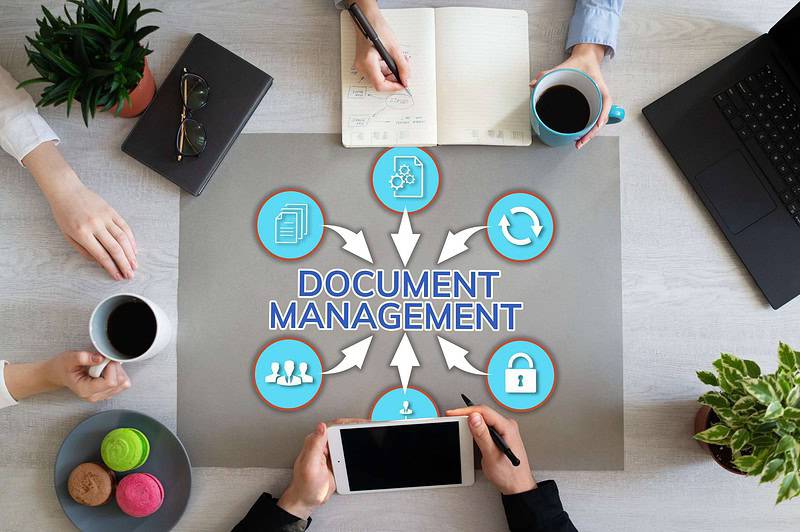-
Top 10 Benefits of Using A Document Management System
Is the paper in your office getting out of hand? Boxes taking up too much space? Or are important documents stored off-site where you can’t easily get to them? There are many good reasons to store business records, but if they’re cluttering things up or you can’t access them, then there’s a problem.
Or maybe your records are already digitized, or at least some of them are. In that case, can you find them easily? Can you access them without hassle, even remotely when needed, or are they stored just on a specific computer? Digital files take up less space than paper ones, but unless you can access them and easily search the files they’re not much more convenient than paper.
An electronic document management system fixes all these problems. At the same time, it reduces paper use and helps your company “go green.”

1) Less Storage Space
Most of us have a pretty good idea of how much space paper files can take up. It can fill rooms if you have a large enough company or many years of records.
When you digitize paper documents, you can store thousands of pages per Gigabyte (GB). Exactly how many depends on what type of files you’re storing. For scanned images, it’s about 15,477 files per GB. For Microsoft Excel, you can count on about 165,791 pages per GB. Even a simple laptop usually has 4 to 12 GB of storage space; imagine how much you could store on company hard drives or by working with a cloud-based document management system.
2) Lower Operating Costs
A 2012 survey by the International Data Corporation (IDC) indicated that troubles with paper-based documentation drive up companies’ operating costs significantly. This IDC white paper said, “This wasted time costs the organization $19,732 per information worker per year and amounts to a loss of 21.3% in the organization’s total productivity.”
The time employees spend working with paper is one of the things that drive up operating costs with paper documents. Storage costs also play a role. An electronic document management system cuts down on storage costs. It also makes managing documents easier for employees, meaning there’s less “wasted” time.
3) More Efficient Time Management
Employees working with paper documents spend a large amount of time creating, filing, and searching for paperwork. For example, on average, respondents to the 2012 IDC survey spent over 2 hours per week “Searching for, but not finding, documents.” That’s a lot of wasted time, which costs the company money and is frustrating for employees.
In contrast, electronic document management systems make it easy to locate documents. Your employees will be able to do full-text searches of the files and easily run reports. In addition, you can work with our document imaging services to outsource scanning paper files, freeing up your employees to focus on other tasks.
4) Easily Search Documents
Have you ever tried doing a keyword search in a PDF only to find that your computer can’t read the file? That sort of thing doesn’t happen with a good data management system.
NextProcess’ use of Optical Character Recognition (OCR) and document image indexing makes your scanned documents truly searchable. Your company can categorize documents easily, do full-text searches to find specific files, and search metadata related to each document. This makes it easy to find the right files quickly.
5) Faster Reporting, Easier Audits
The same features that make it easy to search documents also make reporting easier. Since you can easily find specific files, sort documents, and group files, you’ll be able to compile reports much more quickly. You can also do metadata analysis and reporting at the touch of a button.
These features also make audits easier. It’s much easier on the auditors and your employees if files are easy to search and access. It also means no one needs to worry about tracking down missing files. Plus, the system logs information and leaves an audit trail about who accessed documents, how they edited files, and when access happened.

6) Improved Security
Paper files aren’t all that secure. They’re easily lost or stolen. Keeping backups doubles the amount of storage space you need. A fire or water damage can destroy them completely.
Digital files are easier to secure. You can create and store backup copies very easily. It’s much harder to misplace them or lose them to fire and water, especially if they’re stored or backed up on the cloud. While there is always the possibility of a chance of a data security breach, working with a reliable document management software provider will provide you with state-of-the-art digital security.
7) Better Accessibility
It’s so inconvenient if you’re away from the office and need to reference a file you left on your desk. Similarly, collaborating across locations takes extra time with paper files or even digital ones that aren’t in a centralized document system. You’d need someone to fax or email the file before you could work with it.
With a centralized document management system, employees can log into the system and access files from any internet-enabled device. Passwords and customizable access permissions protect your company’s important data while also making sure the people who need it have access.
8) Enable Collaboration
Improving accessibility and centralizing document storage makes it much easier to collaborate. A good document management system supports efforts to get the whole company working together to solve problems, drive innovation, and much more.
Employees across your company—including those working remotely and in different office locations around the country and world—can easily access the same files. This is particularly important as more employees now work remotely or on a flexible schedule.
9) Integrate With Software Systems
Once your company starts digitizing and automating business processes, it’s important to make sure the different systems can all work together. When you’re implementing a document management system, make sure it’s compatible with your other software programs like ERPs.
NextProcess’ software integrates seamlessly with ERPs including NetSuite and MS Business Central. Plus, we offer a suite of software programs that also integrate with ERPs and work perfectly together. As you digitize your document management, you can also automate accounts payable, purchasing, expense reporting, and more.
10) Improve Compliance
Digitizing documents and standardizing how your company stores them can be a big help with regulatory compliance. For example, NextProcess has a HIPAA-compliant software platform and document intake process so you can use our document management system (and other programs in the software suite) in the healthcare industry.
When your company’s document management system needs help, NextProcess’ software-as-a-service solution can help. We’ll work with you to implement the new system, get it up and running, and customize settings for your company’s specific needs. We can also provide document scanning services for new files coming in on paper and/or for digitizing your existing paper files. Contact us today to learn more or schedule a free demo.
